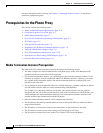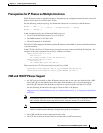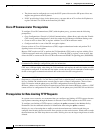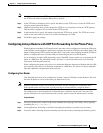
17-14
Cisco ASA Series Firewall ASDM Configuration Guide
Chapter 17 Configuring the Cisco Phone Proxy
Configuring the Phone Proxy
• If you decide to configure a media-termination address on interfaces (rather than using a global
interface), you must configure a media-termination address on at least two interfaces (the inside and
an outside interface) before applying the phone-proxy service policy. Otherwise, you will receive an
error message when enabling the Phone Proxy with SIP and Skinny Inspection.
• The phone proxy can use only one type of media termination instance at a time; for example, you
can configure a global media-termination address for all interfaces or configure a media-termination
address for different interfaces. However, you cannot use a global media-termination address and
media-termination addresses configured for each interface at the same time.
Configuring the Phone Proxy
This section includes the following topics:
• Task Flow for Configuring the Phone Proxy, page 17-14
• Creating the CTL File, page 17-15
• Adding or Editing a Record Entry in a CTL File, page 17-16
• Creating the Media Termination Instance, page 17-17
• Creating the Phone Proxy Instance, page 17-18
• Adding or Editing the TFTP Server for a Phone Proxy, page 17-20
• Configuring Linksys Routers with UDP Port Forwarding for the Phone Proxy, page 17-21
Task Flow for Configuring the Phone Proxy
Note This feature is not supported for the Adaptive Security Appliance version 8.1.2.
Configuring the Phone Proxy requires the following steps:
Step 1: Create the CTL file. See Creating the CTL File, page 17-15.
Step 2: Create the TLS Proxy instance to handle the encrypted signaling. See Adding a TLS Proxy
Instance, page 18-9.
Step 3: Create the Phone Proxy instance. See the “Creating the Phone Proxy Instance” section on
page 17-18.
Step 4: Configure the media termination address for the Phone Proxy. See Creating the Media
Termination Instance, page 17-17.
Note Before you enable SIP and Skinny inspection for the Phone Proxy (which is done by applying the Phone
Proxy to a service policy rule), the Phone Proxy must have an MTA instance, TLS Proxy, and CTL file
assigned to it before the Phone Proxy can be applied to a service policy. Additionally, once a Phone
Proxy is applied to a service policy rule, the Phone Proxy cannot be changed or removed.
Step 5: Enable the Phone Proxy with SIP and Skinny inspection. See SIP Inspection, page 12-20 and
Skinny (SCCP) Inspection, page 12-32.


















